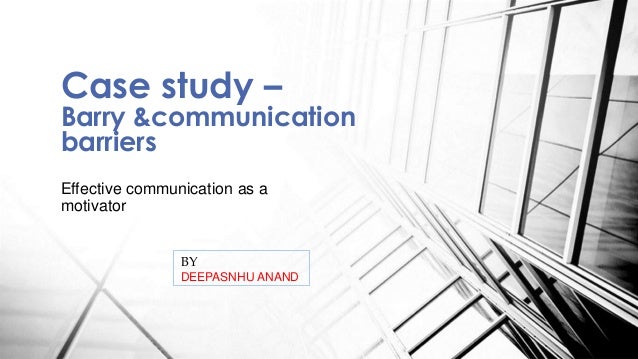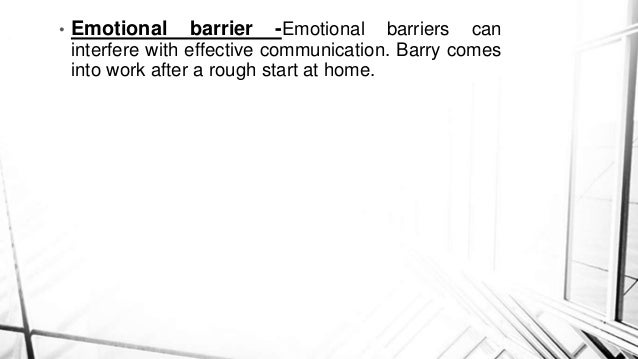
Jul 24, · The mission of the North American Society for Pediatric and Adolescent Gynecology is to provide a forum for education, research and communication among health professionals who provide gynecologic care to children and adolescents. Read more Communication accommodation theory (CAT) is a theory of communication developed by Howard blogger.com theory concerns "(1) the behavioral changes that people make to attune their communication to their partner, (2) the extent to which people perceive their partner as appropriately attuning to them." Communicating with Customers. It is incredibly important that you develop the best communication skills possible with your customers. Some of these skills include speaking clearly, effectively
Why do People Avoid Medical Care? A Qualitative Study Using National Data
For a better experience, case study barriers to communication, click the icon above to turn off Compatibility Mode, which is only for viewing older websites.
In previous years, I have outlined four types of communication, but I believe there are actually five types of communication: verbal, non-verbal, written, listening, and visual, case study barriers to communication. Verbal communication occurs when we engage in speaking with others.
Case study barriers to communication can be face-to-face, over the telephone, via Skype or Zoom, case study barriers to communication, etc.
Some verbal engagements are informal, such as chatting with a friend over coffee or in the office kitchen, while others are more formal, such as a scheduled meeting. Regardless of the type, it is not just about the words, it is also about the caliber and complexity of those words, how we string those words together to create an overarching message, as well as the intonation pitch, tone, cadence, etc.
used while speaking. And when occurring face-to-face, while the words are important, they cannot be separated from non-verbal communication. What we do while we speak often says more than the actual words. Non-verbal communication includes facial expressions, posture, eye contact, hand movements, and touch.
Your boss might be in agreement with your idea verbally, but their nonverbal cues: avoiding eye contact, sighing, scrunched up face, etc. indicate something different. Whether it is an email, a memo, a report, a Facebook post, a Tweet, a contract, etc. all forms of written communication have the same goal to disseminate information in a clear and concise manner — though that objective is often not achieved.
In fact, poor writing skills often lead to confusion and embarrassment, and even potential legal jeopardy. One important thing to remember about written communication, especially in the digital age, is the message lives on, perhaps in perpetuity. Thus, there are two things to remember: first, write well — poorly constructed sentences and careless errors make you look bad; case study barriers to communication second, ensure the content of the message is something you want to promote or be associated with for the long haul.
The act of listening does not often make its way onto the list of case study barriers to communication of communication. Active listening, however, is perhaps one of the most important types of case study barriers to communication because if we cannot listen to the person sitting across from us, we cannot effectively engage with them. Think about a negotiation — part of the process is to assess what the opposition wants and needs.
We are a visual society. Think about from a personal perspective — the images we post on social media are meant to convey meaning — to communicate a message. Others are carefully curated to tug on our heartstrings — injured animals, crying children, etc. We communicate continually throughout each and every day. We do it without thinking — we operate on communication autopilot.
However, I encourage you to think about how you communicate. How do you communicate verbally? What nonverbal cues do you use when you are disinterested? Are you a good listener? Can you write a concise, clearly articulated message? Are there barriers to how you communicate effectively? Understanding how you communicate is the first step to communicating more effectively.
You can easily look online for communication courses. There are a variety of credit and non-credit course available to help you improve your communication skills, including our non-credit series. Home Professional Studies Blog Overview July Five Types of Communication. Posted in interpersonal-communications. Professional Studies Blog Professional Studies Blog December November October September August July The 3 Benefits of Using Ice Breakers 6 Barriers to Effective Communication Five Types of Communication June May April March February January Categories.
Chapter directing case studies on communication barrier
, time: 10:13Communication Barriers - Reasons for Communication Breakdown

Jul 12, · In previous years, I have outlined four types of communication, but I believe there are actually five types of communication: verbal, non-verbal, written, listening, and visual. Verbal Communication Verbal communication occurs when we engage in speaking with others. It can be face-to-face, over the telephone, via Skype or Zoom, etc Nov 12, · Strategies designed to tackle multiple barriers simultaneously (e.g., case management, financial incentives such as cost-reduction strategies or efforts to limit out-of-pocket costs) and comprehensive approaches addressing multiple patient needs (e.g., multidisciplinary team care 45) may be more effective in reducing avoidance than strategies Case Study 1 – Barry and Communication Barriers Effective Communication as a Motivator Barry is a year old who is a foodservice manager at a casual dining restaurant. Barry is responsible for supervising and managing all employees in the back of the house

No comments:
Post a Comment